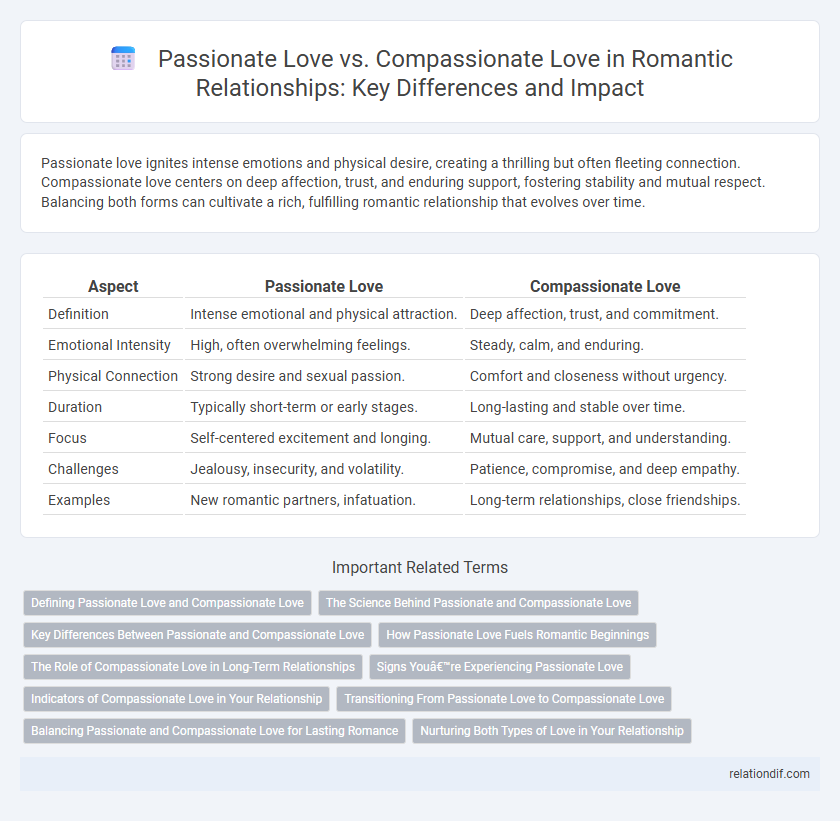Passionate love ignites intense emotions and physical desire, creating a thrilling but often fleeting connection. Compassionate love centers on deep affection, trust, and enduring support, fostering stability and mutual respect. Balancing both forms can cultivate a rich, fulfilling romantic relationship that evolves over time.
Table of Comparison
| Aspect | Passionate Love | Compassionate Love |
|---|---|---|
| Definition | Intense emotional and physical attraction. | Deep affection, trust, and commitment. |
| Emotional Intensity | High, often overwhelming feelings. | Steady, calm, and enduring. |
| Physical Connection | Strong desire and sexual passion. | Comfort and closeness without urgency. |
| Duration | Typically short-term or early stages. | Long-lasting and stable over time. |
| Focus | Self-centered excitement and longing. | Mutual care, support, and understanding. |
| Challenges | Jealousy, insecurity, and volatility. | Patience, compromise, and deep empathy. |
| Examples | New romantic partners, infatuation. | Long-term relationships, close friendships. |
Defining Passionate Love and Compassionate Love
Passionate love is characterized by intense emotions, physical attraction, and an urgent desire for union, often sparking excitement and infatuation. Compassionate love emphasizes deep affection, trust, and mutual respect, fostering long-term connection and emotional intimacy. The distinction lies in passionate love's focus on exhilaration and romance, while compassionate love centers on stability and enduring support.
The Science Behind Passionate and Compassionate Love
Passionate love activates the brain's reward system, flooding it with dopamine and norepinephrine, creating intense feelings of arousal and desire. In contrast, compassionate love engages oxytocin and vasopressin pathways, fostering deep attachment, trust, and long-term bonding between partners. Neuroscientific studies reveal distinct neural circuits for these types, highlighting how passionate love prioritizes attraction and excitement, while compassionate love underpins stability and emotional intimacy.
Key Differences Between Passionate and Compassionate Love
Passionate love is characterized by intense emotions, physical attraction, and a strong desire for union, often igniting quickly and driving the early stages of a romantic relationship. Compassionate love, in contrast, develops over time, emphasizing deep affection, mutual respect, and a commitment to each other's well-being, fostering stability and long-term connection. Key differences include the role of emotional arousal, with passionate love focusing on excitement and longing, while compassionate love centers on care, trust, and enduring support.
How Passionate Love Fuels Romantic Beginnings
Passionate love ignites intense emotions and physical attraction, driving the initial spark that often defines romantic beginnings. This form of love creates a sense of urgency and excitement, making partners feel captivated and deeply connected in the early stages. The powerful biochemical responses, including heightened dopamine and adrenaline levels, sustain this fervent desire and motivation to pursue intimacy and closeness.
The Role of Compassionate Love in Long-Term Relationships
Compassionate love plays a crucial role in sustaining long-term relationships by fostering empathy, mutual respect, and deep emotional connection beyond physical attraction. Unlike passionate love, which centers on intense feelings and excitement, compassionate love strengthens bonds through consistent care and understanding, promoting stability and resilience against relationship challenges. Research indicates couples who cultivate compassionate love experience higher satisfaction and longevity, as this form of love encourages support during both joyful and difficult times.
Signs You’re Experiencing Passionate Love
Rapid heartbeat, intense longing, and constant thoughts about the partner are key signs you're experiencing passionate love. Physical attraction and a desire for close proximity often dominate your emotions, creating an exhilarating and consuming connection. This intense emotional and physical involvement distinguishes passionate love from the steadier, more enduring feelings of compassionate love.
Indicators of Compassionate Love in Your Relationship
Indicators of compassionate love in your relationship include deep empathy, mutual respect, and unwavering support during challenging times. Partners often prioritize each other's well-being, demonstrating patience and understanding without expecting immediate rewards. This form of love fosters long-term connection through shared values, emotional intimacy, and consistent acts of kindness.
Transitioning From Passionate Love to Compassionate Love
Transitioning from passionate love to compassionate love involves a shift from intense physical attraction and emotional arousal to deep mutual respect, trust, and enduring connection. This transformation emphasizes commitment, understanding, and emotional security, allowing couples to cultivate a stable and fulfilling relationship. Neuroscientific studies reveal that while passionate love activates brain areas linked to reward and motivation, compassionate love engages regions responsible for empathy and bonding.
Balancing Passionate and Compassionate Love for Lasting Romance
Balancing passionate love, characterized by intense emotions and physical attraction, with compassionate love, rooted in deep affection and mutual respect, is essential for sustaining lasting romance. Couples who cultivate both elements often experience greater relationship satisfaction, as passionate love ignites excitement while compassionate love fosters trust and emotional security. Integrating these dimensions supports a dynamic yet stable partnership, promoting long-term intimacy and connection.
Nurturing Both Types of Love in Your Relationship
Passionate love ignites intense emotions and physical attraction, while compassionate love fosters deep connection and mutual support. Nurturing both types requires balancing excitement with empathy, engaging in meaningful communication, shared experiences, and consistent emotional availability. Cultivating this blend enhances relationship satisfaction and long-term resilience against conflicts.
passionate love vs compassionate love Infographic

 relationdif.com
relationdif.com